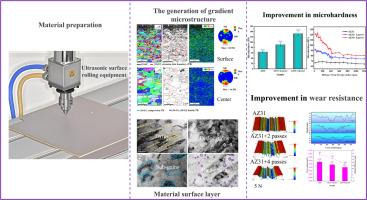The effect of ultrasonic surface rolling process on the gradient microstructure and wear resistance of AZ31 thin sheet
IF 13.8
1区 材料科学
Q1 METALLURGY & METALLURGICAL ENGINEERING
引用次数: 0
Abstract
This study investigates the effects of the ultrasonic surface rolling process (USRP) on the surface microstructure, texture, and wear behavior of commercial AZ31 magnesium alloy sheet. The application of USRP induces a depth-dependent gradient microstructure characterized by a gradual transition from fine-grained surface layers to coarser-grained regions. Severe plastic deformation at the surface significantly enhances surface microhardness, with values increasing from 63.8 HV in the untreated specimen to 132.9 HV after USRP-4 passes. The thickness of the plastic deformation layer exhibits process-dependent behavior, growing from 200 µm (two passes) to 250 µm (four passes). Wear test results indicate that the wear resistance of the material is significantly enhanced after USRP treatment. This improvement is primarily attributed to the combined effects of the following factors: surface grain refinement, the role of dislocation-induced twinning, increased hardness, the formation of nanoscale secondary phases, introduction of residual compressive stresses, weakened surface texture, and reduced surface roughness. Notably, both friction coefficients and wear volumes show a direct dependence on the number of rolling passes. This study systematically elucidates the underlying mechanisms linking USRP-induced microstructural evolution to enhanced wear performance, providing critical insights for optimizing surface engineering strategies in magnesium alloys.

超声波表面轧制工艺对AZ31薄板梯度组织及耐磨性的影响
研究了超声表面轧制工艺(USRP)对AZ31镁合金板材表面组织、织构和磨损性能的影响。USRP的应用诱导了深度相关的梯度微观结构,其特征是从细粒表层逐渐过渡到粗粒区域。表面剧烈的塑性变形显著提高了表面显微硬度,USRP-4通过后,硬度从未处理试样的63.8 HV增加到132.9 HV。塑性变形层的厚度表现出工艺依赖性,从200µm(两道次)增长到250µm(四道次)。磨损试验结果表明,USRP处理后材料的耐磨性明显提高。这种改善主要归因于以下因素的综合作用:表面晶粒细化、位错诱导孪晶的作用、硬度增加、纳米级二次相的形成、残余压应力的引入、表面织构减弱和表面粗糙度降低。值得注意的是,摩擦系数和磨损量都直接依赖于滚动道次的数量。该研究系统地阐明了usrp诱导的微观结构演变与增强磨损性能之间的潜在机制,为优化镁合金表面工程策略提供了重要见解。
本文章由计算机程序翻译,如有差异,请以英文原文为准。
求助全文
约1分钟内获得全文
求助全文
来源期刊

Journal of Magnesium and Alloys
Engineering-Mechanics of Materials
CiteScore
20.20
自引率
14.80%
发文量
52
审稿时长
59 days
期刊介绍:
The Journal of Magnesium and Alloys serves as a global platform for both theoretical and experimental studies in magnesium science and engineering. It welcomes submissions investigating various scientific and engineering factors impacting the metallurgy, processing, microstructure, properties, and applications of magnesium and alloys. The journal covers all aspects of magnesium and alloy research, including raw materials, alloy casting, extrusion and deformation, corrosion and surface treatment, joining and machining, simulation and modeling, microstructure evolution and mechanical properties, new alloy development, magnesium-based composites, bio-materials and energy materials, applications, and recycling.
 求助内容:
求助内容: 应助结果提醒方式:
应助结果提醒方式:


